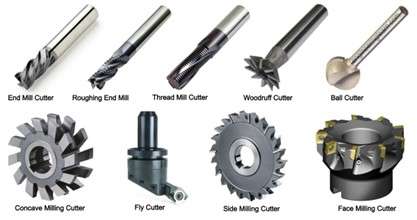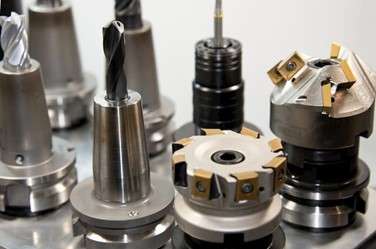A cutting tool is a general term for blades attached to machine tools. Various cutting tools are used according to the purpose at metal processing sites, such as drills, which are familiar in DIY, milling cutters, end mills, and tools.

Different types of cutting tools
Cutting tools are indispensable for the production of molds for molding resin, even for plastic products that seem unrelated to metal processing. Cutting tools are important tools that are indispensable for manufacturing all kinds of industrial products, including smartphones and automobiles that support our lives.
In this article, we will introduce a wide range of cutting tool types and materials.
Cutting tool type
There are various types of cutting tools, such as drills, milling cutters, end mills, and cutting tools, depending on the application. We introduce the types of typical cutting tools.
Milling cutters are cutting tools that are often used in machining centers and milling machines.
End mills, which are called all-purpose tools, are also a type of milling cutter, and can efficiently, cut flat surfaces, sides, grooves, and slits on workpieces.
Types of milling cutters

Type of milling cutters
- end mill
- Face Mill
- flat milling cutter
- side milling
- Metal saw/slit milling
- groove milling
Drill
A drill is a cutting tool that is often used in machining centers and drill presses and is indispensable for drilling.
Various drills are used depending on the diameter and depth of the hole, such as drills with oil holes that facilitate the discharge of chips and long gun drills for deep holes.
Drill type
- twist drill
- drill with oil hole
- center hole drill
- gun drill
- counterbore drill
- stepped drill
- burnishing drill
Tap
A tap is a cutting tool for cutting threads (female threads). In particular, drilling a screw hole with a tap is called “cutting a tap”, and it is a cutting tool that is indispensable for machining machine parts with many screw parts.
Tap type
- point tap
- spiral tap
- thread mill
Bits
Bits are cutting tools that are often used in lathes and turning centers and are indispensable for turning.
The tip of the cutting tool is equipped with a cutting edge called a “tip” or “insert”, which cuts into the rotating workpiece to scrape the surface of the metal.
Machining is performed while exchanging various tools according to the machining process, such as parting tools for machining grooves and boring tools for machining inner surfaces.
Types of bits
- single-edged tool
- sword bite
- parting tool
- boring tool
- thread cutting tool
- knurling tool
- rotary bite
Reamer
A reamer is a cutting tool used to finish the inner diameter and surface roughness of a drilled hole.
A cutting tool that is indispensable for drilling holes in automobile engine parts, aircraft parts, etc., which require high precision.
Other cutting tools
Generally speaking, cutting tools refer to blades with high versatility, but various cutting tools are used as specialized tools.
Grinding wheel
A grinding wheel is a special tool made by hardening “abrasive grains” with a “bonding agent” and is used in grinders.
Although it is not strictly defined as a cutting tool, it is an indispensable tool for finishing precision parts.
Hob
Hobs are specialized tools used in gear-processing machines such as hobbing machines and gear-cutting machines.
There are various types of hobs, depending on the type of gear and processing method.
Brooch
A broach is a special tool used on a broaching machine. It is used for special broaching such as key grooves for automobile parts and splines for engine parts.
Cutting tool material
Materials such as tool steel, high-speed steel, carbide, and diamond are used for cutting tools.
“Hardness” and “toughness (tenacity)” also vary depending on the tool material. In order to demonstrate high accuracy in the harsh environment of cutting, it is important to use them properly according to the work to be processed and the cutting conditions.
Types of materials for cutting tools
- Carbon tool steel and alloy tool steel
- High-speed tool steel (HSS)
- cemented carbide
- cermet
- ceramics
- CBN
- Diamond (single crystal diamond)
- PCD (sintered diamond)
Related terms for cutting tools
| cutting conditions |
Cutting conditions are a combination of “cutting speed”, “cutting depth”, “feed amount” and “cutting time”. Since cutting conditions directly affect machining efficiency and tool wear, it is necessary to set optimal conditions according to machining details and workpiece materials. |
| cutting force |
Cutting force is the load applied when the cutting tool is pressed against the workpiece. If a large surface is to be cut at one time, the cutting resistance increases, causing chattering and deterioration of the machined surface. |
| cutting heat |
Cutting heat is the heat generated by the friction between the cutting tool and the workpiece. Increased cutting heat can cause a built-up edge and chipping of the cutting edge, so it is necessary to cool with coolant and review cutting conditions. |
| tool life |
Tool life is the period during which a cutting tool can be used with high accuracy. In the field, it is sometimes judged based on the deterioration of machining accuracy and changes in chips due to wear. |
| Chip control performance |
Chip control performance is the performance of processing chips generated during cutting. In general, cutting efficiency increases as the feed rate of cutting tools increases, but high chip control performance is required because a large number of chips are generated in a short period of time. |
Tooling of cutting tools
Tooling has a “tool holder” to hold the cutting tool and a “shank” to connect the cutting tool to the machine tool.
Various standards and types are depending on the machine, and using the appropriate tooling according to the processing content is the key to improving accuracy and preventing processing defects.
Types of tool holders
- Collet chuck
- milling chuck
- Hydraulic chuck
- shrink fit chuck
- Stub holder (for the dedicated machine)
Shank type
- BT shank
- BBT Shank
- HSK Shank
- CAPTO Shank (Capto)
What is machine tool tooling?

Cutting tool with coating
The coating is an essential surface treatment technology for cutting tools.
By coating, the surface of the cutting tool with a thin film, the characteristics (weak parts) of the original tool material are covered. Tool life can be improved by selecting the most suitable coating tool according to the workpiece material and cutting conditions.
Types of coating tools
- Titanium coating
- Chrome-based coating
- DLC coating
Tool length measurement of cutting tools
A special device called a tool setter is used to measure the tool length (tool length) of cutting tools.
By measuring the length of the tool and feeding it back to the NC of the machine tool, it is possible not only to locate the origin when changing the tool but also to detect wear and chipping of the cutting tool during machining. It is an important device indispensable for the unmanned operation of CNC machine tools
Types of tool setters
- contact tool setter
- laser tool setter
- Tool setter for NC lathe
- tool presetter
- Simple tool setter
Regrinding of cutting tools
Solid tools (tools with an integrated cutting edge) such as end mills and drills are generally reground and reused.
By regrinding the tool before it wears out, you can maximize tool life and reduce costs.
Many of the specialized tools used in the processing of aircraft parts are expensive, costing hundreds of thousands of yen or more, and are designed to be used after being re-polished multiple times. After regrinding, re-coating is required.
A special machine tool called a tool grinder is used for regrinding.
Cutting Tool Grinding Technician:
Cutting is a processing method in which a cutting tool is pressed against metal or the like to shave the surface. Cutting tools are attached to the turrets of machine tools, etc., and their processing requires high precision. “Cutting tool grinding occupation” is intended for the work of grinding cutting tools.
To sum up
In this article, we have explained the cutting tools used in machine tools and related technologies.
In order to perform cutting efficiently while maintaining high precision, it is important to combine the optimum “tool material”, “tooling” and “coating” according to the workpiece and cutting conditions.
At Prolean our CNC experts have many years of experience in the field of CNC machining, and they know how to choose the right tool for high-precision machining. In this way, the lead time and the quality of parts can be guaranteed. If you are interested in machining any of your drawings, please feel free to contact us, and we will get your production plan and quote in a few hours.




0 Comments
Trackbacks/Pingbacks